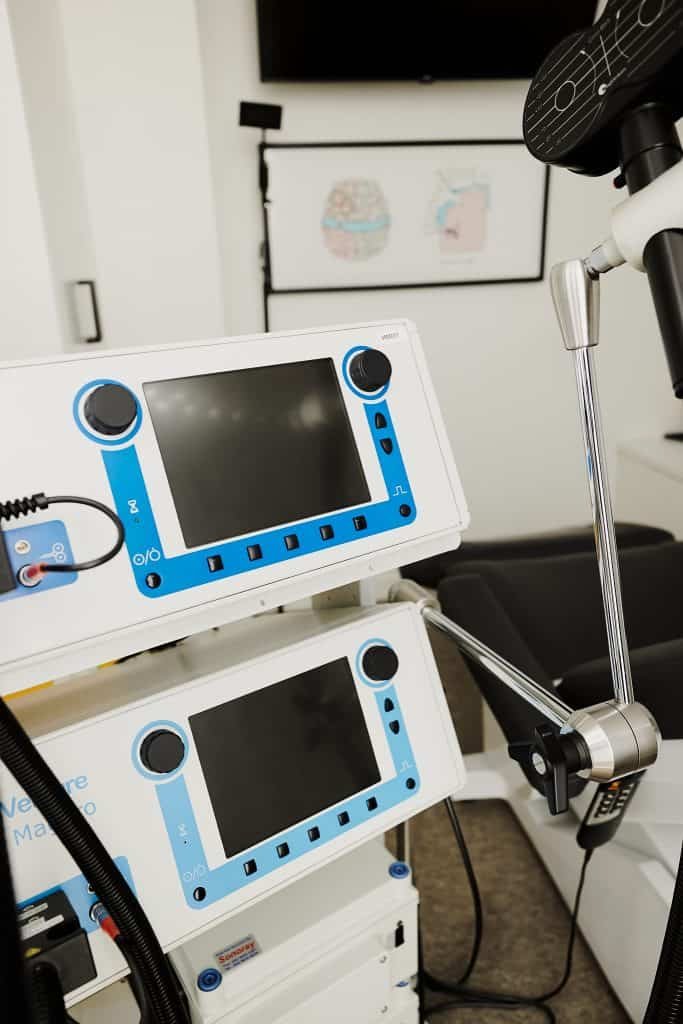Repetitive Transcranial Magnetic Stimulation (rTMS) therapy is a non-invasive treatment approved by the Therapeutic Goods Administration (TGA) for managing major depressive disorder (MDD), particularly when medications or psychotherapy have not been effective.
At Brain Aid Clinics, we offer neuronavigated rTMS – a form of rTMS with a higher degree of accuracy.
Many individuals experience symptomatic relief during the initial treatment phase, but questions often arise about the need for ongoing maintenance TMS treatments and their frequency. In this article, we provide an overview of maintenance TMS and what to consider for long-term mental health support.

Understanding the Initial Course of TMS Therapy
The initial TMS treatment phase typically involves:
- 3-5 sessions per week
- Over 4 to 6 weeks
- A total of 35 sessions
Many patients notice improvements in symptoms during or shortly after this period. For some, this provides sustained relief, while others may benefit from maintenance sessions to prolong the effects and reduce the risk of symptom recurrence.
What Are Maintenance TMS Treatments?
Maintenance TMS involves additional sessions after the initial course to help sustain symptom relief and support ongoing mental health. These sessions are not necessary for everyone but may be considered for individuals who:
- Experience a return of symptoms after the initial treatment
- Wish to manage seasonal or stress-related depressive episodes
- Have a history of recurrent or chronic bouts of their condition (eg depression)
The goal of maintenance TMS is to sustain the benefits achieved during the initial (acute) rTMS therapy, attempting to prevent symptom relapse or recurrence, particularly for conditions like depression (MBS funding available) or chronic pain.
How Often Are Maintenance Treatments Needed?
The frequency of maintenance TMS sessions varies depending on individual factors, including:
- Response to the initial treatment course
- Mental health history
- Current lifestyle and stress levels
Some individuals may benefit from a single session monthly, while others might require:
- A booster cycle every 3–6 months
- One session every few weeks during high-stress periods
- A short re-treatment course if symptoms return significantly
Consultation with a healthcare professional at Brain Aid Clinics is essential to determine an appropriate schedule tailored to individual needs.

Funding Considerations for Maintenance TMS
In Australia, funding for TMS varies. Medicare may provide rebates for the initial course of TMS for treatment-resistant depression, subject to eligibility criteria. However, maintenance TMS sessions are often not covered by Medicare or private health insurance and may involve out-of-pocket costs. Patients should discuss funding options with their healthcare provider or insurance fund for clarity.

Recognising the Need for Maintenance TMS
Indicators that maintenance TMS sessions may be beneficial include:
- A decline in mood, energy, or motivation
- Increased anxiety, irritability, or sleep disturbances
- Difficulty concentrating or a return to negative thought patterns
Early consultation with a healthcare professional can help determine if maintenance TMS is appropriate to prevent a significant return of symptoms.
Conclusion
Maintenance TMS treatments could play a role in supporting long-term mental health for some individuals, with the frequency tailored to personal circumstances. If you’re considering maintenance TMS, speak with your doctor or a mental health specialist to discuss whether it’s suitable for you and to develop a personalised plan.
Frequently Asked Questions
No worries at all! The only thing to consider is whether you’ve previously qualified for Medicare funding. That said, we’re more than happy to consult with any patients and provide the care you need.
Contact us on info@brainaidclinics.com to find out more.
Maintenance TMS involves additional sessions after the initial course of TMS treatment, to sustain symptomatic relief and support mental health. These sessions may benefit those who:
- Notice a return of symptoms, post-treatment
- Seek to manage seasonal or stress-related depressive episodes
- Have a history of recurrent or chronic depression (or other symptoms, such as pain)
The aim is to stimulate targeted brain regions to prevent symptom escalation.
The frequency varies based on:
- Response to the initial treatment
- Mental health history
- Lifestyle and stress factors
Options may include a monthly session, a booster cycle every 3–6 months, or sessions during high-stress periods, as advised by a healthcare professional.
TMS delivers magnetic pulses to stimulate brain regions like the left dorsolateral prefrontal cortex, which is involved in mood regulation, aiming to support mental health outcomes.
Consider maintenance TMS if you notice:
- A decline in mood, energy, or motivation
- Increased anxiety, irritability, or sleep issues
- Difficulty concentrating or returning negative thought patterns
Consult a healthcare professional to discuss whether maintenance TMS is appropriate for you.
